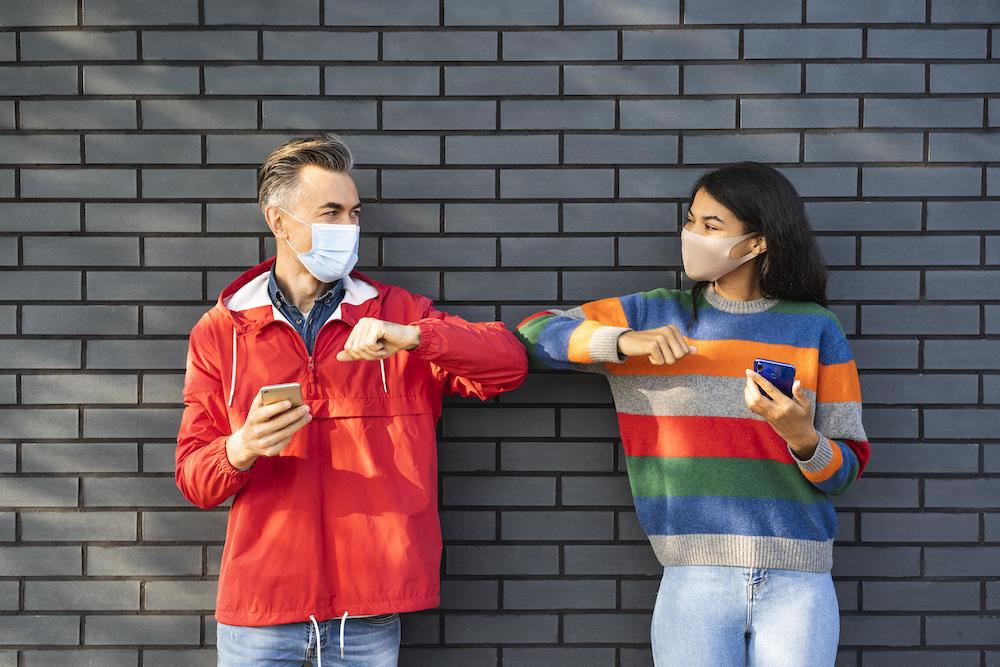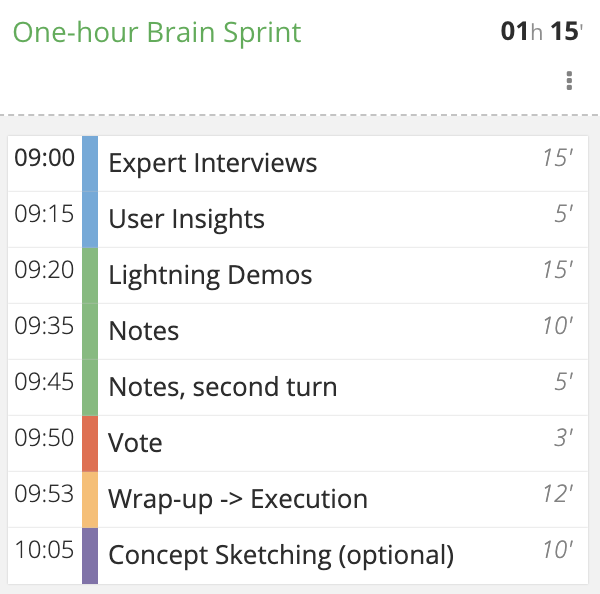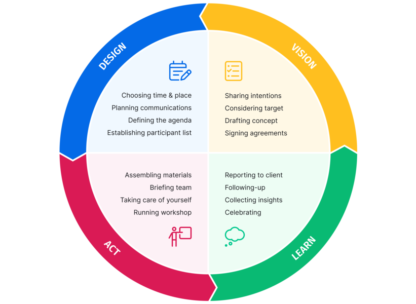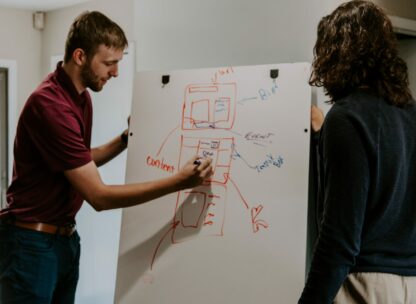8 things I learned facilitating socially distanced workshops

For many workshop participants, returning to a live environment after such a long time away can be stressful, tense or just plain odd! For some, the prospect of a socially distanced workshop is scary enough to be a barrier to entry and can seriously affect the efficacy of your session.
To define the term, a socially distanced workshop is a live workshop where measures designed to limit close contact are in effect.
This might mean limiting participant numbers, using large rooms with carefully distributed seating, the wearing of masks, the limiting of movement around the room, or other factors based on local or organizational guidelines.
I ran a series of creative workshops for young people this summer designed to engage creative and critical skills and create meaningful connections under these conditions.
This meant needing to redesign for a socially distanced learning environment, replan activities, and reconnect with an audience who likely hadn’t been in a creative workshop for a long period of time.
While we’ve covered how to run virtual workshops and facilitate remotely before, there were lots of things to learn for this new setting too!
Here are eight of the main things I learned from the experience of facilitating in this new and somewhat challenging environment. Let’s dig in!
- 1. People really missed workshops (and making connections)
- 2. People might need extra help bringing themselves into socially distanced sessions
- 3. New ideas come from adversity and interaction
- 4. Leading by example has never been more important
- 5. Be clear and patient when discussing workshop etiquette
- 6. Try redesigning activities before removing them
- 7. Remember to create space for reflection and don’t be afraid to hold the silence
- 8. Things take longer, so know where your agenda can bend and squeeze
1. People really missed workshops (and making connections)
As facilitators, we hope that our sessions will have an impact and resonate with our participants. In the current global situation, it’s worth acknowledging that the workshops we run might be one of the few opportunities our participants have to connect with like-minded people.
In my own practice, this meant allowing more space for connection and adjusting my own expectations. I had to acknowledge the purpose of a workshop is often more multifaceted than a single, concrete goal.
Design for connection first
Bear in mind that balancing your primary goal alongside the need for human connection has never been more important. Coming during a period where many people are feeling disconnected, I felt it was important to design these sessions for connection first.
This meant allowing time for group discussions and breaks to go on for longer and creating additional space in the agenda for discussion and small group work. I also made sure to include a balance of activities that meant people could meaningfully engage with one another alongside deeper work.
Consider how to balance single, pair and group work
1-2-4-All is a workshop activity I’ve used time and time again in both live and remote workshops. I used the activity here, though, upon consideration of the format, group size, and room set-up, I swapped to a 1-2-All format.
Firstly, this was so I could give special emphasis to the pair work portion of the activity. In my experience, more meaningful interpersonal connections – particularly about creative subjects – occur when working in pairs. The subject is often personal, and pair work allows for a safe, engaged sharing environment with the minimum of distractions.
Secondly, skipping the small group step meant I could guide larger group discussion, model the ideal method of engagement, and ensure everyone felt seen, heard, and safe to share. All while carefully observing social distancing and working with the existing room set-up.
All workshop design is a balancing act. By keeping the desire for reconnection and peer engagement in the front of my mind, I felt that my agenda design best reflected the needs and goals of the participants and we had a great session as a result.
2. People might need extra help bringing themselves into socially distanced sessions
Every workshop group is different. Even before the pandemic, we would have participants who were 100% up for whatever we threw at them, while others needed more time to feel psychologically safe and engage with the group.
I think it’s worth reiterating that many people are feeling less psychologically safe or able to participate at this moment in time. In my experience, people really want to engage with others in these settings, they just need a little extra help to warm up and be gently eased into the workshop.
Set up the room for safety
Creating a safe, comfortable environment is a great first step. Remember to plan your room set up for social distancing and ensure everyone can enter the room safely and not feel pressured to put themselves at risk.
Space working areas apart, create clear lines of travel to and from the room and take extra steps with the arrangement to make your group comfortable.
In my case, this meant arranging seating so that it was close enough to have conversations and create a collegial atmosphere, but far enough away to observe the two-meter rule.
For this, I created a U-shape table set-up, with a single chair in the center of each table. This meant all participants were spaced two meters apart, had ample room to work safely, and could also converse with the person next to them easily. The U-shape set-up also enabled the group to all see one another and listen effectively during full group discussion.
I also positioned the tables and chairs in the center of the room, allowing for ample space for each participant to comfortably exit the room without coming into close proximity with other participants.
This really helped create a safe atmosphere where people could grab some water or take a comfort break without worrying about breaking social distancing rules or putting themselves at risk.
During this period of global uncertainty, baseline preparedness among participants is likely lower and we should plan our sessions and interactions accordingly.
When choosing a workshop location, keep in mind that you’ll want space to allow for free movement while observing the correct amount of distance. You may need to find a larger space or limit the number of participants accordingly.
Use music
As someone who has used music to mixed results before, I wasn’t completely convinced it was an important ingredient for an effective workshop. In the socially distanced classroom, I found that using music for groups entering the room and to guide them while engaging in reflective work really helped create a safe, pleasant environment.
I used a Spotify playlist for concentration that featured classical music and music from film scores. This created nice moments of recognition and potential talking points within the group while keeping things chilled.
Ultimately, I feel that we all have lots of things influencing our mood right now that can be quite hard to affect. Music has proved to be a simple way to positively counter-balance our collective mood and move things gently in the right direction.
Pay attention to your warm-ups
I also made sure to put special emphasis on the icebreaker and warm-up activities. I was careful to make sure people did not feel ambushed or asked to share too much too soon. As such, the icebreaker and warm-up activities I used were simple and gentle while also introducing the topics of the workshop.
In one session, I asked participants to bring their favorite book to the session with them or have it in mind. The icebreaker was to recommend the book to the other person, tell them why it’s their favorite, and share what they think we might learn from it as writers.
Knowing all the participants were keen readers, it followed that they would be excited and able to discuss a favorite book without much difficulty. The energized and passionate conversations that followed were a great way to get the workshops started!
I’d recommend it as an icebreaker in any setting, especially if you are able to include a final question that can relate to your workshop theme.
Warming people up and breaking the ice with a group has always been an important step. During this period of global uncertainty, baseline preparedness is likely lower and we should plan our sessions and interactions accordingly.
3. New ideas come from adversity and interaction
One of the things I love about running workshops is how the agenda can evolve and change because of how participants interact and engage with the content. This is even more true in socially distant meetings or virtual workshops, where many of our existing exercises and activities need to change in order to work in these new environments.
Entire activities can be upended by a group’s reaction and though this can be scary as a facilitator, it’s a great opportunity for learning and growth!
In one example, social distancing meant we could no longer have people write and add post-its to a shared wall. I still felt it would be effective to have everyone create their own stack of post-its in order to capture ideas and remove the fear of the blank page.
Invention often comes out of adversity and as facilitators, we should pay attention to how participants instinctively engage with activities in order to learn and develop even better sessions.
In one session with 9-12-year-olds, I gave individuals the go-ahead to organize their post-its (and ideas) in whatever way felt good and natural to them. This meant that participants then used and engaged with their post-its in interesting ways.
Some participants organized their post-its in neat columns, rows, shapes, and patterns, while others attached their favorite post-it ideas to their arms, legs, and forehead for others to read.
This led me to consider how I might make using post-its even more fun, and use participants’ inclinations to use post-its in unusual ways in future activities.
How might an arm and a leg respond differently to a design problem? How might we each map out an idea differently and show our thought processes instinctively using our bodies or different shapes?
My point here is that invention often comes out of adversity and as facilitators, we should pay attention to how participants instinctively engage with activities in order to learn and develop even better sessions.
4. Leading by example has never been more important
Leading people through a group process has always meant considering the effect we have as facilitators. Igniting passions, helping promote self-discovery, and raising energy levels are things many of us think about as we lead a group through a workshop process.
In these socially distanced workshops, I found participants looked to me for direction and to set the tone and energy levels of the session even more so than normal. Being conscious of this and preparing myself accordingly helped make these sessions more fun and effective while keeping sight of what the group needed.
Consider participating
Just as the situation has meant people are out of workshop practice or need a little extra direction, so too must we model the kind of behavior we want to see from participants.
I found that engaging in some of the creative activities alongside students or have a pair discussion with my co-facilitator had a profound effect on group engagement.
There will always be different approaches when it comes to participating vs facilitating a workshop but as we return to live workshops, it’s worth considering how helpful it can be to model how to do an exercise and engage with others in practical terms too.
Model safe behaviour
Leading by example in this setting also means modeling proper social distancing behavior, remembering to wear your mask where necessary, and helping people be safe while working together. It can be so easy to forget certain social distancing rules or get lost in a group process you might not have done in a while!
I also found that remembering to check in with myself beforehand and preparing a checklist including these additional items before the session was especially useful here. I was a little out of practice too!
Keeping the potential unease of participants front of mind when engaging in the workshop and ensuring I set the right example at every stage meant I was better prepared to facilitate whatever happened.
Want to run more engaging workshops and meetings?
5. Be clear and patient when discussing workshop etiquette
The pandemic has meant that many of us are out of the live workshopping and meeting habit. Just as some participants needed a little extra help in bringing themselves to the workshops, others needed some help following directions and corralling their energies.
For example, some participants needed a little refresher on active listening or would get over-excited and have trouble following directions. I also found that I couldn’t take shared understanding of certain tasks or codes of conduct for granted as I might have done previously.
Taking the time to articulate good workshop and conversational etiquette at the outset of a session has always been good practice, but as we return to workshopping in a live setting, it’s worth reiterating.
Be clear about what you expect from your workshop participants, state those expectations in concrete terms where possible, don’t take anything for granted, and be patient – remember that returning to the setting might be stressful or anxiety-inducing.
Try including a code of conduct in your invitations (especially around social distancing), model good workshop behavior, and don’t be afraid to guide the group if they go wrong. It might even be worth including activities designed to teach good workshop etiquette early in the session.
Remember that some of us have simply forgotten how to do workshops and as facilitators, it’s our job to bring people back into the room meaningfully, helpfully, and respectfully.
In addition to general workshop etiquette, outlining the format and expectations of this socially distanced workshop was an important aspect of planning and running the session.
In my case, it was important to reiterate the following items for this socially distanced workshop:
- Masks should be worn when not seated (unless medically exempt)
- Hands should be sanatized frequently
- Leaving the room is fine, though please follow the assigned route and sanitize your hands upon entry and exit
- Please maintain one metre plus distance with other participants
- Snacks and drinks will be provided and will be individually wrapped
- Full sanitisation of seats, handrails, tables, doors and all other contact points will take place before and after each session.
- Windows will be open to increase ventilation
- Materials will be provided and sanatized before and after use
Remember that all organizations, groups, and countries will have their own rules and guidelines that should be followed and are prone to change. Keep up to date and relate any of these items to your participants. This will not only help keep everyone physically safe but ensure they’re comfortable and reassured too!
6. Try redesigning activities before removing them
In my facilitation practice, one of my key focuses is on creating connections and building shared joy around being creative and expressing yourself. Understandably, the socially distanced workshop could be considered a barrier to this process!
In the design stage, I had to reconsider how some of my tried and tested activities could work with social distancing and an environment where we had to keep students seated as much as possible.
This led to two options – remove activities that weren’t suitable for the setting in favor of something simpler or redesign them to work in the setting.
Know when to redesign
While redesigning some activities isn’t easy, trying to work with the setting and create something special instead of selecting the easier route felt really important to me.
Keeping the goals of the workshop in mind was a key part of making this decision. If the activity is integral to the outcome, that’s a good candidate for a redesign. If the activity is a simple energizer, maybe it could be swapped out without much impact.
For example, I often use a creative exercise I adapted from a great user experience activity where participants would trade chocolates and interview one another until they ended up with one they liked.
Thanks to Sara Chizari for sharing this method in her Medium article on running an empathy workshop.
In my version, I start by handing participants a random card containing an archetypal character, places or objects. These archetypes include characters like The Mother, The Warrior, The Mentor, and are a great way to start discussing stories, ideas, and why we might be drawn to them.
Once everyone has a card, participants then discuss in pairs what they like and dislike about their cards and where they might have seen the archetype before. Next, they trade cards with other group members until they get a card (and archetypal idea) that they really like.
The lesson in both exercises is the same – people are drawn to certain ideas or likes, and when designing and writing, we should think of who it is for and what they will be drawn to as well.
It’s important to understand ourselves, and our audience, in both writing and design, if we are to create something with purpose and meaning.
Giving someone who hates nuts a peanut butter chocolate isn’t a great approach, nor is writing a romance story for a horror audience, or trying to write a sci-fi if you don’t know and like science fiction.
Instead of saying, “I can’t run that exercise in this setting,” ask, “How could I run that exercise? What is the core outcome of the activity and how might I still achieve that under these new conditions?”
Because of social distancing, getting up and moving around the room to trade archetypes wasn’t possible. Rather than throw out the activity – which I’ve found to be effective and engaging in the past – I elected to redesign the activity for the setting.
Instead of a single round of trading as a group, I had three successive rounds where I gave out archetype cards, though I changed the level of choice participants had at each stage.
In the first round, people were given an archetype character card at random. They could either keep their card or swap it for another random card. I then asked the group to free-write around the card they received.
In a later round, we came back to the archetypes and I gave each participant three archetypal location cards to choose from and add to their ideation mood board. Finally, I laid out the archetypal object cards for everyone to see and had each participant choose the one they wanted the most.
I felt it was important to maintain the elements of choice, discussion, and creative reflection of this activity, even if I couldn’t maintain the trading aspect. The result was a fun exercise that allowed the desired conversations and insights to surface while still prompting creativity – all while maintaining social distancing and safety.
Be receptive to the opportunities that come from redesign
When running this adapted activity, I changed how the cards were selected. Instead of being given out one by one randomly, I placed a number of the cards face down on a central table at the beginning of the session.
As a result, there was an element of wonder, expectation, and a talking point for participants too. This was something I totally missed when running the original exercise.
Without having to account for social distancing and redesign the activity, I wouldn’t have made this discovery. In the end, the situation meant I learned something I will use in many future workshops, whether they’re socially distanced or not.
The point here is that instead of saying, “I can’t run that exercise in this setting,” ask, “How could I run that exercise? What is the core outcome of the activity and how might I still achieve that under these conditions?”
By considering how I could amend the exercise for this setting, I found a great compromise that was effective and generated new ideas too!
Inevitably, not every exercise can be run in a virtual, hybrid or socially distanced environment. But by first asking if it can be adapted, you might find creative workarounds or new ideas!
7. Remember to create space for reflection and don’t be afraid to hold the silence
One of my challenges as a facilitator has been in allowing myself to be more comfortable with silence. Allowing conversation to happen at its own pace and giving time for reflection without forcing it has been something I’ve had to work on – my instinct is to jump in and get things moving!
Just as many participants are relearning how to workshop under these conditions, so are we as facilitators. It was a great reminder to be aware of myself and be more comfortable with holding the silence, letting conversations emerge steadily, and allow space for participants to reflect.
My advice here is to trust the process and to trust people. If you’ve created the right environment and are supporting the process, connections and insights will occur – they just might take a little longer than you’re used to or need some gentle guidance without forcing things.
Remember that silence is a chance for reflection and reappraisal and that it is a vital part of the process too.
8. Things take longer, so know where your agenda can bend and squeeze
One effect of the relearning process is that tasks, activities, and discussions might take longer. For participants and facilitators, renegotiating the territory of the live, socially distanced workshop takes time.
What might have been a simple activity before the pandemic might take more set-up, or group discussions might overrun because of our being out of practice. This is okay! The key is to know what is most important in your group process and where your agenda can change if necessary.
In the workshops I ran, setting up and concluding activities took a little more time than normal. Group discussions took a little longer to get going and so went over time. Something as simple as moving from one side of the room to the other to get a drink was now a little more complicated because of how we had to negotiate the space.
All told, there were numerous small things that meant time got eaten up more swiftly than previously.
I made sure to note down where changes occurred in my agenda and what happened so I might plan better and make changes in the future. Keeping records is an important part of the development of better workshops!
Before the session, I anticipated this might be the case and so pre-labeled those parts of my agenda that could be cut down, swapped for alternatives, or skipped altogether. I made sure to note which parts of my process were integral so I could ensure the process was a success, whatever might change during the session.
It’s also worth mentioning that because of my goal for creating meaningful connections, I let other activities go on for longer than I had allocated time for.
Being aware of the needs of the group and allowing more time for what is working has always been important – in the socially distanced workshop, this is arguably even more true!
I made sure to note down where changes occurred in my agenda and what happened so I might plan better and make changes in the future. Keeping records is an important part of the development of better workshops!
Making changes to the agenda mid-session has been something facilitators have always had to consider. Be sure to acknowledge the potential for additional overrun when leading socially distanced sessions and plan accordingly.
Wrap up
Facilitation has always been a profession about working with and creating change. In periods of upheaval such as a global pandemic, workshops have had to change too.
The important thing to remember is that our role as facilitators is still the same – to help guide a group through a process and towards their goals.
The socially distanced workshop is undoubtedly a challenge to some of our traditional working methods and facilitation practices. But with some creativity and a dedication to creating meaningful experiences, we can continue to inspire and engage participants, whatever the setting.
Have you engaged in socially distanced facilitation? Do you have any tips on how to make workshops engaged in this format? We’d love to hear from you!




Leave a Comment